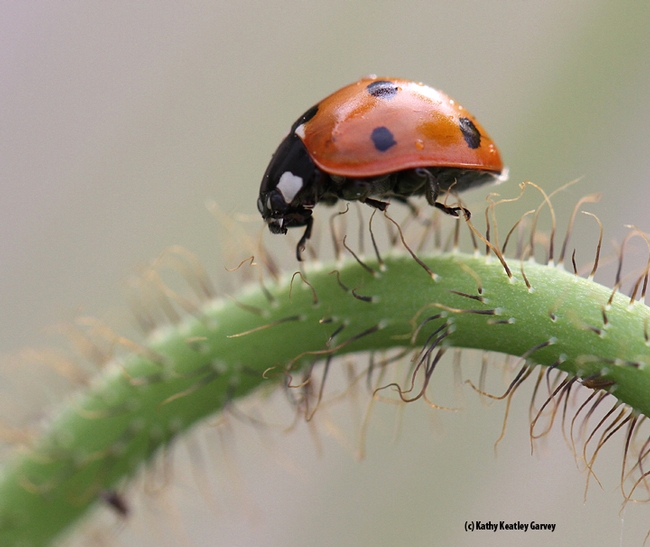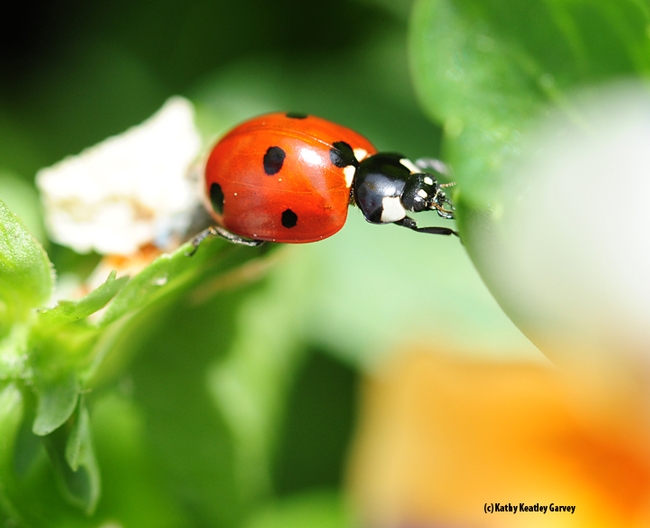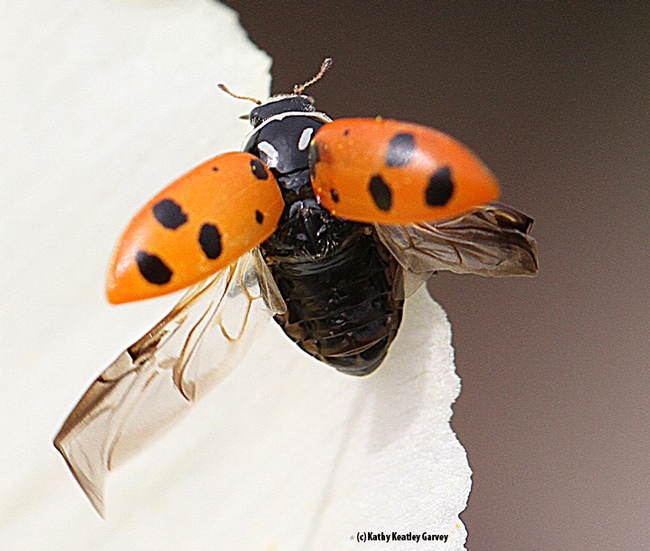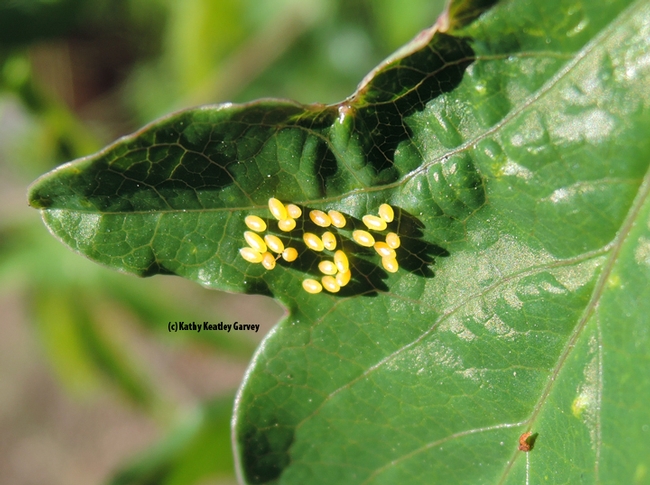- Author: Kathy Keatley Garvey

And appropriately, butterflies adorned his tie.
Smith, who curates the 400,000 butterfly and moth collection at the Bohart Museum, was nominated by Lynn Kimsey, director of the Bohart Museum and professor of entomology at UC Davis.
Smith sat on stage with the other 2015 recipients: Jacqueline Beckley, Chuck Nichols and Tony Smith, alumni awards; Chris van Kessel, faculty; David Ginsburg, staff, and John Meyer, friend.
But since this is a Bug Squad blog, we'll focus on the "bugman." (Yes, "bugman" is in his email account.)
Smith has “brought us international acclaim and saved us $160,000 through donations of specimens and materials, identification skills and his professional woodworking skills," Kimsey wrote in her nomination. "This does not include the thousands of hours he has donated in outreach programs that draw attention to the museum, the college and the university.”
Kimsey praised Smith for completely reorganizing the butterfly and moth collection. “It's no small feat to rearrange this many specimens, housed in roughly one thousand drawers,” she said. “Many thousands of the specimens needed to be identified, and the taxonomy required extensive updating and reorganization.”

Lauding Smith's “phenomenal knowledge of urban insect and spiders,” Kimsey said: “We often go to him with questions we get from the public and from colleagues. He volunteers for our weekend open houses as often as he can, as well as the UC Davis Biodiversity Museum Day in February and UC Davis Picnic Day in April. Few volunteers, faculty, students or staff work as well with the public as Jeff does. He has a wonderfully engaging way of talking to children and adults, and he knows just how to inspire and educate every age group. It's awesome to watch.”
Indeed, it is no easy feat to pin a butterfly or moth. Just ask research entomologist Tom Zavorink, a Bohart Museum associate.
"Personally, I am astounded by the thousands upon thousands of butterflies and moths that Jeff has prepared for display or scientific study," Zavorink said. "This is no small task because butterfly and moth specimens are usually brought from the field in envelopes or boxes with their wings folded over their backs or around their bodies, and preparing them for display or scientific study involves relaxing them in a humid chamber so their wings and legs can be manipulated, carefully spreading open the wings, positioning them on a flat surface, and securing them in that position until the specimen dries again. This is an onerous task that many entomologists, myself included, shun because we don't have the time, manual dexterity, or patience it takes to prepare quality specimens."
Smith puts it this way: “Entomology is my passion and the Bohart Museum is my cause.”
The Bohart Museum houses a global collection of nearly eight million specimens. It is also the home of the seventh largest insect collection in North America, and the California Insect Survey, a storehouse of the insect biodiversity. Noted entomologist Richard M. Bohart (1913-2007) founded the museum.
The Bohart Museum's regular hours are from 9 a.m. to noon and 1 to 5 p.m. Mondays through Thursdays. The museum is closed to the public on Fridays and on major holidays. Admission is free. Open houses, focusing on specific themes, are held on weekends throughout the academic year. See open house schedule.

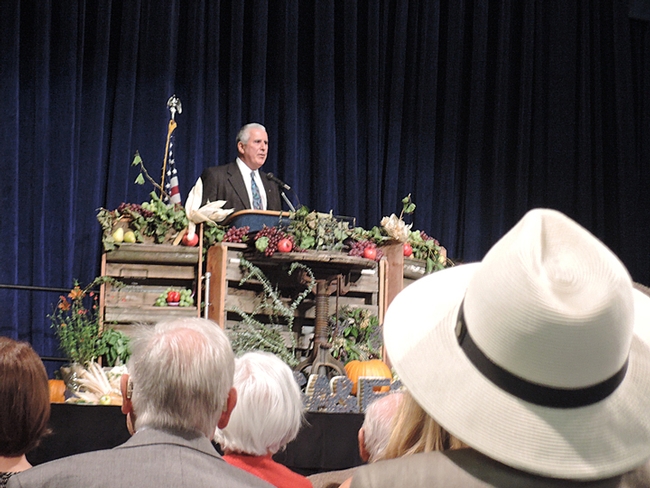
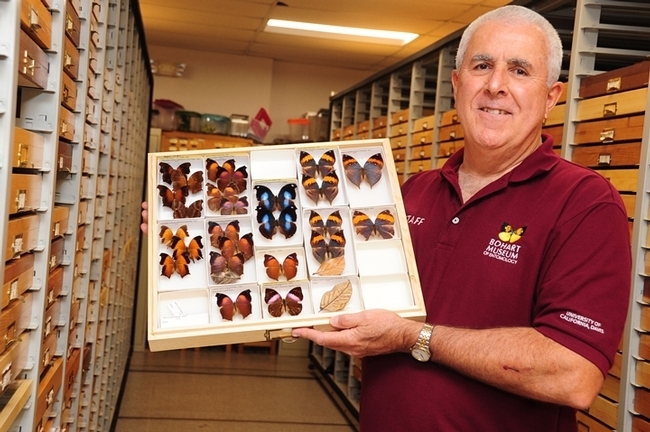
- Author: Kathy Keatley Garvey

So says ecologist Richard 'Rick' Karban, professor of entomology, UC Davis Department of Entomology and Nematology, and author of the newly published book, Plant Sensing and Communication (University of Chicago Press).
Over the past several years, we've heard Karban speak about plant communication at UC Davis and beyond. His talks always draw an enthusiastic crowd.
Whenever I see Gulf Fritillary caterpillars chewing on our passionflower vine (yes, we planted the vine for the butterflies), I wonder what the plant is sensing with all that crunching, munching and chomping going on. Sometimes a scrub jay will swoop down and grab a beakful of caterpillars. Sometimes a praying mantis or European paper wasp will target the 'cats. Sometimes I feel sorry for the passionflower vine--especially after the 'cats have defoliated it, leaving only scarred stems.
It's a battlefield out there, and so fascinating.
So we asked Karban "What are 10 things to know about plant sensing and communication?"
Here's the list:
- Plants sense their environments and respond.
- Although they lack central nervous systems, they process information and appear to "behave intelligently."
- They sense the position of competitors and "forage" for light.
- They sense the availability of water and nutrients in the soil and "forage" for these resources.
- Their decisions are influenced by past experiences, akin to memory.
- The respond to reliable cues that predict future events, allowing them to "anticipate."
- Plants respond differently to cues that they themselves produce, allowing them to distinguish self from non-self.
- They respond differently to close relatives and strangers.
- Plants that are prevented from sensing or responding experience reduced fitness.
- By understanding the "language" of plant responses, we can grow healthier and more productive plants.
The 240-page book is a “landmark in its field,” said Graeme Ruxton of the University of St. Andrews, UK, co-author of Experimental Design for the Life Sciences and Plant-Animal Communication.
“Karban seeks to argue that plants behave—that they sense their environment, detect and communicate with an array of different organisms, and respond to their sense of the environment and communication,” Ruxton said. ”He is very successful in this, demonstrating that plant sensing and communication is a vibrant area of current research with still plenty more to discover.”
The book is “the first comprehensive overview of what is known about how plants perceive their environments, communicate those perceptions, and learn,” according to the publisher. “Facing many of the same challenges as animals, plants have developed many similar capabilities: they sense light, chemicals, mechanical stimulation, temperature, electricity, and sound. Moreover, prior experiences have lasting impacts on sensitivity and response to cues; plants, in essence, have memory."
Karban has researched plant communication in sagebrush (Artemisia tridentata) on the east side of the Sierra since 1995. His groundbreaking research on plant communication among kin, published in February 2013 in the Proceedings of the Royal Society B: Biological Sciences, drew international attention. In that study, Karban and his co-researchers found that kin have distinct advantages when it comes to plant communication, just as “the ability of many animals to recognize kin has allowed them to evolve diverse cooperative behaviors.”
“Plants responded more effectively to volatile cues from close relatives than from distant relatives in all four experiments and communication reduced levels of leaf damage experienced over the three growing seasons,” they wrote.
In other words, if you're a sagebrush and your nearby kin is being eaten by a grasshopper, deer, jackrabbit, caterpillar or other predator, communication is more effective if you're closely related. Through volatile cues, your kin will inform you of the danger so you can adjust your defenses.
Karban likened this kind of plant communication to eavesdropping.” Plants “hear” the volatile cues of their neighbors as predators damage them.
Karban is featured in the Dec. 23-30, 2013 edition of The New Yorker in Michael Pollan's piece, “The Intelligent Plant: Scientists Debate a New Way of Understanding Plants."

- Author: Kathy Keatley Garvey

Sound familiar?
Honey bee scientist and noted author Mark Winston will speak on “Bee Time: Lessons from the Hive” at a special seminar hosted by the UC Davis Department of Entomology and Nematology on Friday, June 5 at 10 a.m. in 122 Briggs, Kleiber Hall Drive.
The title is also the title of his newest book, published by Harvard University Press. All interested persons are invited to attend.
“There are powerful lessons to be learned from bees about how we humans can better understand our place in nature, engage the people and events surrounding us with greater focus and clarity, interact more effectively in our relationships and communities, and open ourselves to a deeper understanding of who we are as individuals, communities and a species,” Winston said. “I'll talk about my experiences over 30 years of walking into apiaries, and the lessons learned from a life spent among the bees.”
Winston is a professor and senior fellow, Centre for Dialogue, Simon Fraser University, Harbour Centre, Vancouver, Canada, and is also a professor in the university's Department of Biological Sciences.
Winston is particularly known for his book, The Biology of the Honey Bee, on the bookshelves of almost every honey bee researcher and beekeeper, said Extension apiculturist Elina Niño, who will introduce him.
Winston is described as that rare individual, a scientist, who can speak eloquently to the public. "Recognized as one of the world's leading expert on bees and pollination, Mark has had an illustrious career researching, teaching, writing and commenting on bees and agriculture, environmental issues and science policy," his website says.
Winston received two degrees from Boston University: a bachelor of science degree in biology in 1971 and a master's degree in marine biology in 1975. He earned his doctorate in entomology from the University of Kansas in 1978.
We can all learn a lesson or two about bees, those amazing creatures often taken for granted.

- Author: Kathy Keatley Garvey

Evolutionary ecologist Amy Toth of Iowa State University, Ames, Iowa, will speak on "Molecular Evolution in Insect Societies: Insights from Genomics of Primitively Social Paper Wasps" at a seminar hosted Wednesday, May 13 by the UC Davis Department of Entomology and Nematology.
Toth, an assistant professor in the Department of Ecology, Evolution and Organismal Biology, Department of Entomology," will speak from 12:10 to 1 p.m. in 122 Briggs Hall.
"The evolution of highly cooperative, eusocial behavior from solitary ancestry represents one of the major transitions in the evolution of life," says Toth. "Thus, understanding the evolution of insect eusociality can provide important insights into the evolution of complexity. Recently, with the advent of the genomic era, there has been great interest in understanding the molecular underpinnings of social behavior and its evolution. Several hypotheses about how eusociality have been proposed; these ideas can be roughly divided into two camps—one proposes that eusociality involved new (novel, or rapidly evolving) genes, and the other, that old (deeply conserved) genes took on new functions via shifts in gene regulation."
In her seminar, Toth will provide an overview of recent research in her laboratory aiming to address the genomic basis of social evolution in insects, with a focus on gene expression. "Utilizing a comparative approach involving multiple species and lineages of bees and wasps, as well as de novo sequencing of genomes, transcriptomes, and epigenomes, our work aims to trace the types of genomic changes related to the evolutionary transition from solitary to eusocial behavior," she said.
Toth will present results from several lines of research mainly focused on primitively social Polistes paper wasps, that have led to the following insights:
- Relatively minor shifts in gene expression patterns may accompany earlier stages of social evolution
- Convergent evolution of social behavior in different lineages involves similar gene expression patterns in a small set of key pathways, and
- Epigenetic mechanisms such as DNA methylation are variable across species and evolutionarily labile.
"Although more data on additional solitary and social species, and on novel genes, are needed, the emerging picture is that earlier transitions from solitary to simple eusociality involved relatively small changes in gene expression and regulation," she said.
Toth said she is especially interested in the mechanisms and evolution of insect sociality, using paper wasps and honey bees as model systems.
Toth received her bachelor's degree in biology in 2006 from Bard College, Annandale-on-Hudson, New York and her doctorate in ecology and evolutionary biology in 2006 from the University of Illinois, Urbana-Champaign, where she was advised by major professor Gene Robinson. She did postdoctoral work with Christina Grozinger at Pennsylvania State University, where she was a USDA postdoctoral fellow. She focused on uncovering conserved molecular pathways for social insect reproduction and social behavior. Earlier she was a postdoctoral research associate with the Department of Entomology and Institute for Genomic Biology, University of Illinois, where she studied with advisor Gene Robinson. Her work centered on genomic analyses of insect social behavior.
Plans call for recording her seminar for later posting on UCTV.
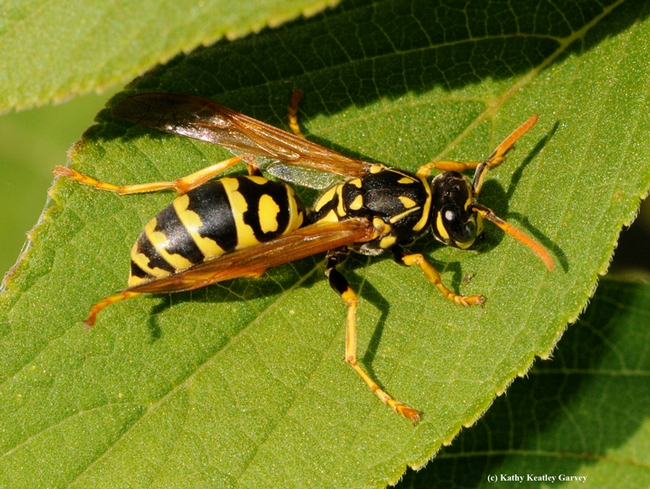
- Author: Kathy Keatley Garvey
Who wouldn't like to have a lady beetle, aka ladybug?
Although they're commonly called "ladybugs," entomologists call them "lady beetles." That's because they're beetles, not bugs.
Nevertheless, who wouldn't like to have one?
The California Grange traditionally gives away lady beetles at the annual California Ag Day, held around the first day of spring on the west lawn of the state capitol. These beneficial insects gorge on aphids and other soft-bodied insects.
We took ours home and placed one on a Iceland poppy stem and another on a rose bush.
And then we photographed them as a sort of "proof of life." Out of the container and into the garden. Go get 'em, lady beetles!
Lady beetles belong to the family Coccinellidae, derived from the Latin word coccineus, which means "scarlet." However, not all lady beetles are red. Some are red, yellow, black, gray, or brown. Some have spots or stripes. Some have no markings at all.
They're sometimes confused with the spotted cucumber beetle, a yellowish green dome-shaped insect with black spots, but that one is a pest.
If you want your own lady beetles, you can usually buy them at a hardware store. Or on Saturday, April 18, you can stop by Briggs Hall during the annual UC Davis Picnic Day and receive free lady beetles from the UC Statewide Integrated Pest Management Program (UC IPM). (You can also engage in maggot art, cockroach races, termite trails, honey tasting, and other fun activities that the UC Davis Department of Entomology and Nematology is planning.)
As for the lady beetles, we're promised more. Last week we received a special gift--a cluster of 24 eggs deposited on our passion flower vine (Passiflora).
